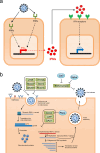Interferon-stimulated genes and their antiviral activity against SARS-CoV-2
- PMID: 39171921
- PMCID: PMC11389394
- DOI: 10.1128/mbio.02100-24
Interferon-stimulated genes and their antiviral activity against SARS-CoV-2
Abstract
The coronavirus disease 2019 (COVID-19) pandemic remains an international health problem caused by the recent emergence of the severe acute respiratory syndrome coronavirus 2 (SARS-CoV-2). As of May 2024, SARS-CoV-2 has caused more than 775 million cases and over 7 million deaths globally. Despite current vaccination programs, infections are still rapidly increasing, mainly due to the appearance and spread of new variants, variations in immunization rates, and limitations of current vaccines in preventing transmission. This underscores the need for pan-variant antivirals and treatments. The interferon (IFN) system is a critical element of the innate immune response and serves as a frontline defense against viruses. It induces a generalized antiviral state by transiently upregulating hundreds of IFN-stimulated genes (ISGs). To gain a deeper comprehension of the innate immune response to SARS-CoV-2, its connection to COVID-19 pathogenesis, and the potential therapeutic implications, this review provides a detailed overview of fundamental aspects of the diverse ISGs identified for their antiviral properties against SARS-CoV-2. It emphasizes the importance of these proteins in controlling viral replication and spread. Furthermore, we explore methodological approaches for the identification of ISGs and conduct a comparative analysis with other viruses. Deciphering the roles of ISGs and their interactions with viral pathogens can help identify novel targets for antiviral therapies and enhance our preparedness to confront current and future viral threats.
Keywords: COVID-19; ISG; SARS-CoV-2; innate immunity; interferon.
Conflict of interest statement
The authors declare no conflict of interest.
Figures


Similar articles
-
Antiviral Activity of Type I, II, and III Interferons Counterbalances ACE2 Inducibility and Restricts SARS-CoV-2.mBio. 2020 Sep 10;11(5):e01928-20. doi: 10.1128/mBio.01928-20. mBio. 2020. PMID: 32913009 Free PMC article.
-
Innate immune signatures in the nasopharynx after SARS-CoV-2 infection and links with the clinical outcome of COVID-19 in Omicron-dominant period.Cell Mol Life Sci. 2024 Aug 22;81(1):364. doi: 10.1007/s00018-024-05401-1. Cell Mol Life Sci. 2024. PMID: 39172244 Free PMC article.
-
SARS-CoV-2-mediated evasion strategies for antiviral interferon pathways.J Microbiol. 2022 Mar;60(3):290-299. doi: 10.1007/s12275-022-1525-1. Epub 2022 Feb 5. J Microbiol. 2022. PMID: 35122601 Free PMC article. Review.
-
Elevated temperature inhibits SARS-CoV-2 replication in respiratory epithelium independently of IFN-mediated innate immune defenses.PLoS Biol. 2021 Dec 21;19(12):e3001065. doi: 10.1371/journal.pbio.3001065. eCollection 2021 Dec. PLoS Biol. 2021. PMID: 34932557 Free PMC article.
-
Mechanisms of Antiviral Immune Evasion of SARS-CoV-2.J Mol Biol. 2022 Mar 30;434(6):167265. doi: 10.1016/j.jmb.2021.167265. Epub 2021 Sep 22. J Mol Biol. 2022. PMID: 34562466 Free PMC article. Review.
Cited by
-
Epidemiology, Clinical Significance, and Diagnosis of Respiratory Viruses and Their Co-Infections in the Post-COVID Era.Pathogens. 2025 Mar 7;14(3):262. doi: 10.3390/pathogens14030262. Pathogens. 2025. PMID: 40137747 Free PMC article. Review.
-
From Structure to Function: Isatin Derivatives as a Promising Class of Antiviral Agents.Curr Drug Targets. 2025;26(7):470-488. doi: 10.2174/0113894501352560250115054156. Curr Drug Targets. 2025. PMID: 39878104 Review.
-
Diverse effects of coronavirus-defective viral genomes on the synthesis of IFNβ and ISG15 mRNAs and coronavirus replication.Virol J. 2025 Feb 14;22(1):37. doi: 10.1186/s12985-025-02654-5. Virol J. 2025. PMID: 39953551 Free PMC article.
References
-
- Menachery VD, Yount BL, Debbink K, Agnihothram S, Gralinski LE, Plante JA, Graham RL, Scobey T, Ge XY, Donaldson EF, Randell SH, Lanzavecchia A, Marasco WA, Shi ZL, Baric RS. 2015. A SARS-like cluster of circulating bat coronaviruses shows potential for human emergence. Nat Med 21:1508–1513. doi:10.1038/nm.3985 - DOI - PMC - PubMed
Publication types
MeSH terms
Substances
Grants and funding
LinkOut - more resources
Full Text Sources
Medical
Research Materials
Miscellaneous

